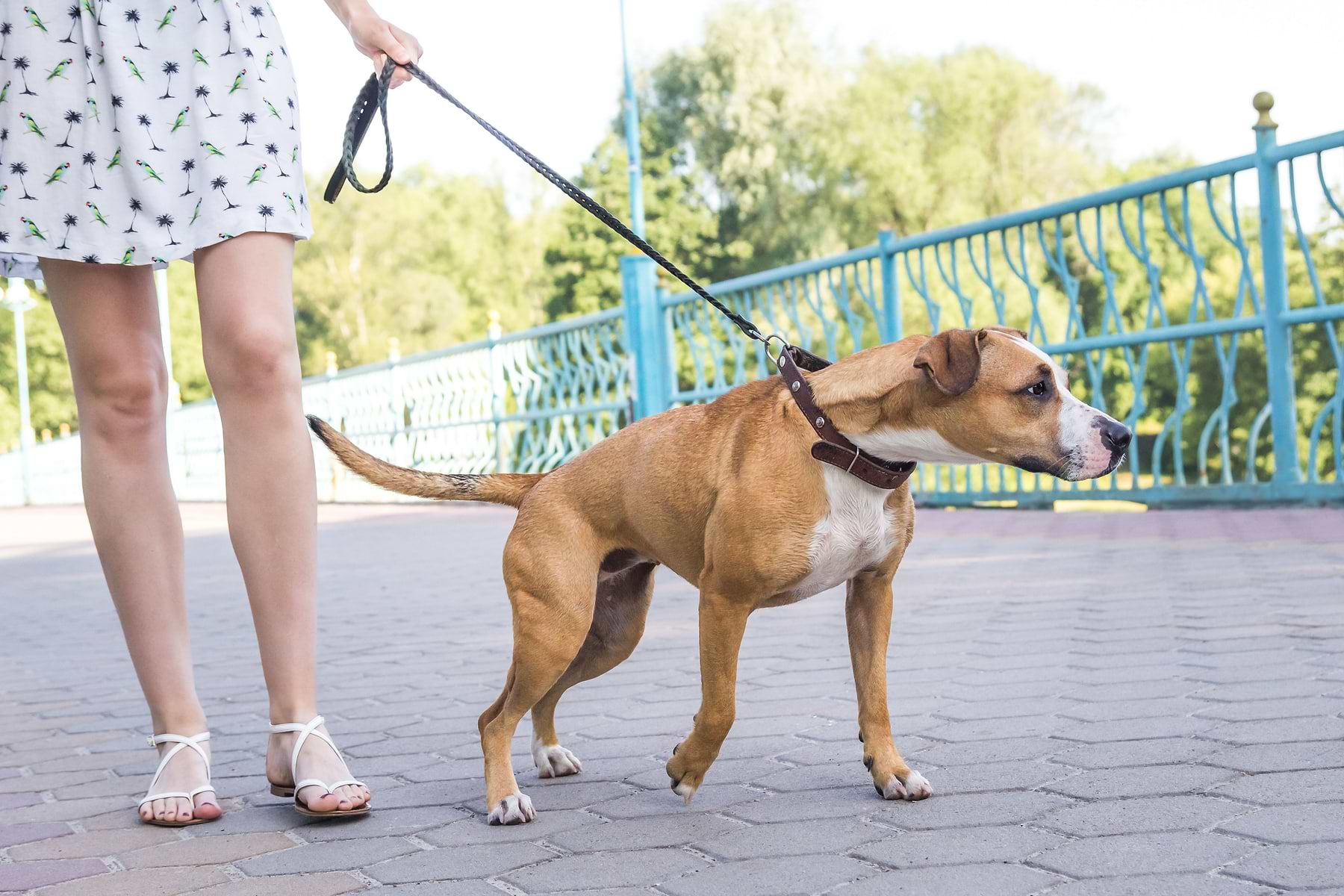Taking your dog for daily walks is a great way to provide mental stimulation and physical exercise. But if your dog doesn’t walk politely, it can turn a pleasant stroll into a nightmare. Lots of dogs struggle on leash, refusing to walk, dragging their parents down the sidewalk, or lunging and barking at strangers. If this sounds like your dog, take a look at these tips.
Does Your Dog Refuse to Walk?
When you clip on your pup’s leash, do they put on the brakes and refuse to move? Do you end up having to drag them down the sidewalk? This happens most often with young puppies who are either confused about their collar and leash or overwhelmed by the outside world. If this describes your dog, don’t worry about teaching polite walking behavior quite yet. You’ll want to get your dog enthusiastic about walking, then teach loose leash walking later.
First, help your pup feel comfortable wearing a collar. Every time you snap the clasp closed, praise your puppy then give them a treat or toy. You can also play the “Gotcha” game by gently grabbing your dog’s collar then feeding them a treat. This will teach your pup that their collar predicts good things. Never use the collar to yank your dog around or they will develop negative associations with this necessary accessory.
Second, teach your dog that a leash predicts good things, too. Start with short sessions in the house. Leash your puppy then play with them while providing lots of treats. When your puppy starts to relax, try walking them around the living room using treats to lure them along. Next, move to the yard for leashed walks and playtime. Only when your dog will happily walk with you in these situations are you ready to take things to the sidewalk.
Finally, socialize your dog to the outside world. Make sure they meet all kinds of people and see all types of dogs. Let them move at their own pace and reward them for being brave. If your puppy seems excessively anxious or you have a fearful adult dog, enlist the help of a dog trainer or behaviorist who can walk you through desensitizing and counterconditioning your dog to the things that scare them.
Does Your Dog Drag You Down the Street?
Dogs have places to go and smells to sniff, but we humans walk too slowly for their taste. That’s why many pups drag their owners down the sidewalk: it gets them where they want to go. But, if you let your dog walk when they pull you, you’ve rewarded them for that behavior, and they’ll pull again in the future. Instead, plant your feet and stand still. Wait for your dog to come back to you or at least ease up on the leash. As soon as the tension is gone, resume your walk. When your dog hits the end of the leash and pulls again, repeat the process. In time, your dog will realize that a loose leash means they can walk, whereas a tight leash gets them nowhere.
When you’re training your dog not to pull, make it easy for them to stay calm on leash. If you can, exercise them before your walks by playing fetch in the yard or tug-of-war in the living room. Next, ask your dog to sit quietly when you clip on the leash. There’s no point in stepping out the door if your dog is already revved up. Once you’re outside, reward your dog for staying close to you with treats and toys. Try to deliver your first reward before your dog even takes a step to show them that good things happen if they stay near your legs. You can also change direction frequently and reward your dog when they turn and catch up.
Finally, never pull on the leash. A leash is meant for safety, not control. If you drag your dog or hold the leash taut, you’ll confuse your pup and set back the training process. Plus, most dogs will react by pulling even harder in return. Instead, keep the leash in a loose J shape and train your dog to pay attention to you and follow your lead.
Does Your Dog Lunge at People or Other Dogs?
Dogs with leash reactivity overreact to ordinary situations while on leash. They might growl, snap, or lunge at another dog, a passerby, or a bicycle. Whether it’s motivated by frustration, aggression, or fear, it’s embarrassing for you and stressful for your pup. If your dog is a lunger, manage your walks to avoid your dog’s triggers (people, dogs, or objects that precipitate the lunging)—even if that means driving to a quieter neighborhood first thing in the morning. Prevent them from practicing the behavior, otherwise, it becomes ingrained and harder to change. If you do encounter a trigger, be proactive. Turn the other way or distract your dog before they have a chance to lunge.
To treat your pup’s reactivity, teach them what to do instead of lunging. A great option is the “watch me” cue which tells your dog to look at your face instead of the environment. Start training in a distraction-free location and pile on the treats when your pup complies. Slowly add more and more distractions before asking for “watch me” on a walk. With enough practice and reinforcement, your dog will love looking your way. Now, when you see a trigger down the street, use “watch me” and reward your pup heavily for choosing to look at you instead of lunging at the trigger.
It also helps to change your dog’s perception of people or other dogs by pairing the presence of a trigger with treats, toys, or games. However, you need to position your dog far enough away that they don’t react. Then, whenever your dog notices a trigger, immediately offer a reward. As your dog learns to associate their triggers with good things, you can move closer and closer. This process can be challenging and time-consuming, so the help of an animal behaviorist or experienced dog trainer can make all the difference.
Does Your Dog Bark on Walks?
Some dogs bark at strangers or other dogs while they’re on a walk. If your pup is overly vocal, be sure they’re getting enough socialization. If the world is overwhelming, your dog will overreact. But if they’ve seen it all before, they’re more likely to stay calm. Also, provide your dog with adequate mental and physical exercise, so they don’t have excess energy to burn off by barking.
Just like with lunging, you can be proactive with barking. Keep your distance from others while out on a walk so your dog doesn’t feel the need to vocalize. Cross the street or turn around when you spy your dog’s triggers. You can also ask your pup to focus on you with a “watch me” cue or an obedience behavior like sit. This teaches your dog that the sight of other dogs or people is a chance to earn a reward by attending to you instead.
We hope these tips help you tackle your dog’s on-leash challenges. Stay patient and consistent, and don’t hesitate to get professional help if your pup needs it. In no time, those walks you used to dread will become an enjoyable way to spend time with your dog.

Stephanie Gibeault
Stephanie Gibeault is a freelance writer and certified professional dog trainer with a Master of Science in animal behavior. She is passionate about combining her love of animals with her writing skills to educate and entertain. When she’s not at her keyboard, you can find her tap dancing, taking photographs, or tweeting (@GibeaultWrites).
You might also like
Crate training tips, stories and inspiration
View all blogsIn Your Diggs
Share your photos with #DiggsPet and tag us @DiggsPet on IG and TikTok.



